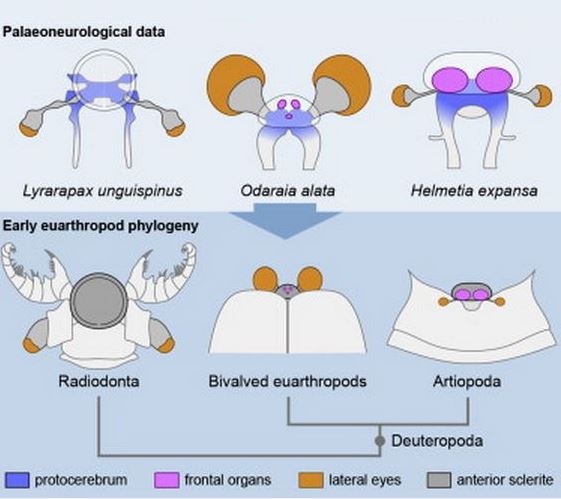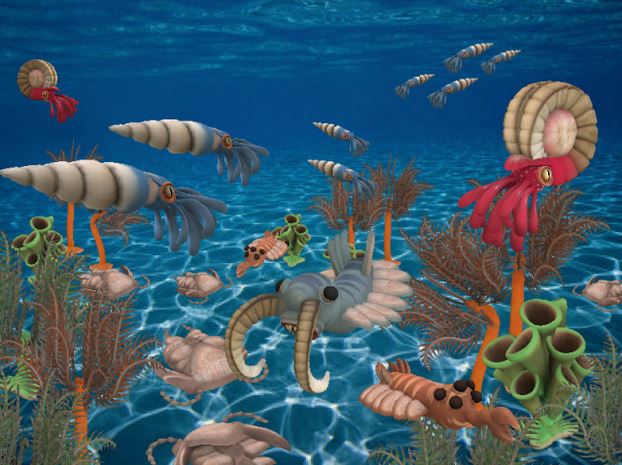A 500 million-year-old fossilised brain, discovered at Burgess Shale in the Canadian Rockies, is helping scientists determine how the heads of early animals first evolved during the Cambrian Explosion, a period of relatively rapid transformation of life forms on Earth, a University of Cambridge researchers said.
The discovery identifies an important point in the evolutionary transition from soft bodies to hard bodies in the early ancestors of arthropods – invertebrate creatures having a segmented body, an exoskeleton, and jointed appendages such as spiders, insects and crustaceans.
Postdoctoral researcher at Cambridge’s Department of Earth Sciences, Dr. Javier Ortega-Hernández, who published details of the latest discovery in the journal Current Biology, looked at two arthropod ancestors – Odaraia alata, a strange-looking creature that resembled a submarine, and a soft-bodied trilobite (a fossil aquatic arthropod that was common during the Palaeozoic era).

He found that the anterior sclerite (a hard plate) and eye-like characteristics at the front part of their bodies connected to each other through nerve traces originating from the front part of their brains, which corresponds to how modern arthropods see things.
The results also allowed comparisons with a large group of big aquatic predators of the period – anomalocaridids. Dr. Ortega-Hernández found several similarities between the anterior sclerite and a plate located on the top of anomalocaridids’ head, suggesting that the species had a common origin.
Although anomalocaridids are the ancient ancestors of arthropods, their bodies are, in fact, fairly different.
Thanks to the incredibly well-kept brains in these fossils, scientists are not able to see that the anterior sclerite is a bridge between the head of anomalocaridids and that of the modern jointed arthropods.
The emergence of hard-bodied creatures
Dr Ortega-Hernández explained:
“The anterior sclerite has been lost in modern arthropods, as it most likely fused with other parts of the head during the evolutionary history of the group.”
“What we’re seeing in these fossils is one of the major transitional steps between soft-bodied worm-like creatures and arthropods with hard exoskeletons and jointed limbs – this is a period of crucial transformation.”
The author noticed that the bright spots at the front part of their bodies, which are actually simple photoreceptors, are embedded into the anterior sclerite.
The photoreceptors connect to the anterior part of the fossilised brain, the same way they do with modern arthropods.
Dr Ortega-Hernández believes these ancient brains probably processed information in the same way those of arthropods today do, and were essential for seeking food, escaping from predators, and interacting with the environment.

Hard-bodied creatures started appearing during the Cambrian Explosion, also known as the Cambrian Radiation.
The Cambrian Explosion
The Cambrian Explosion was a geologically brief evolutionary period that started approximately 542 million years ago, during which most major animal phyla appeared, according to fossil records.
Creatures with jointed limbs and hard exoskeletons – arthropods – started appearing around 500 million years ago, during the Cambrian Explosion.
Before this period, the majority of visible life forms were algae- or jelly fish-like creatures with soft bodies.
Determining how brains evolved is not an easy task, because brains are made of fatty-like substances that do not fossilise well.
Even in the Burgess Shale, one of the world’s most celebrated fossil fields, finding brain tissue is extremely rare.
Dr. Ortega-Hernández said:
“Heads have become more complex over time. But what we’re seeing here is an answer to the question of how arthropods changed their bodies from soft to hard.”
“It gives us an improved understanding of the origins and complex evolutionary history of this highly successful group.”
Citation: Javier Ortega-Hernánde. “Homology of Head Sclerites in Burgess Shale Euarthropods,” Current Biology. DOI: 10.1016/j.cub.2015.04.034.
